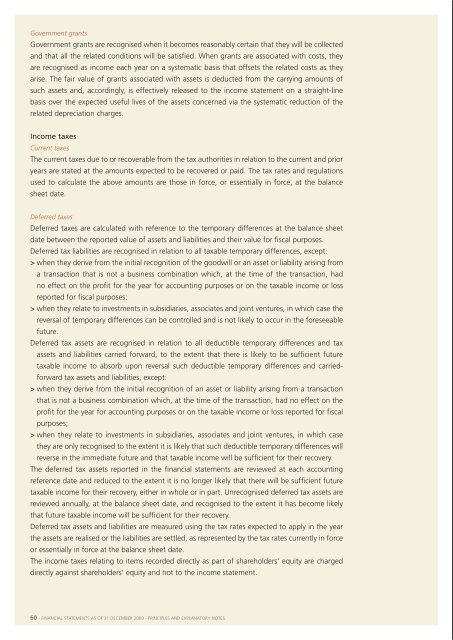Financial Statements 2009 - Manutencoop
Financial Statements 2009 - Manutencoop
Financial Statements 2009 - Manutencoop
You also want an ePaper? Increase the reach of your titles
YUMPU automatically turns print PDFs into web optimized ePapers that Google loves.
Government grantsGovernment grants are recognised when it becomes reasonably certain that they will be collectedand that all the related conditions will be satisfied. When grants are associated with costs, theyare recognised as income each year on a systematic basis that offsets the related costs as theyarise. The fair value of grants associated with assets is deducted from the carrying amounts ofsuch assets and, accordingly, is effectively released to the income statement on a straight-linebasis over the expected useful lives of the assets concerned via the systematic reduction of therelated depreciation charges.Income taxesCurrent taxesThe current taxes due to or recoverable from the tax authorities in relation to the current and prioryears are stated at the amounts expected to be recovered or paid. The tax rates and regulationsused to calculate the above amounts are those in force, or essentially in force, at the balancesheet date.Deferred taxesDeferred taxes are calculated with reference to the temporary differences at the balance sheetdate between the reported value of assets and liabilities and their value for fiscal purposes.Deferred tax liabilities are recognised in relation to all taxable temporary differences, except:> when they derive from the initial recognition of the goodwill or an asset or liability arising froma transaction that is not a business combination which, at the time of the transaction, hadno effect on the profit for the year for accounting purposes or on the taxable income or lossreported for fiscal purposes;> when they relate to investments in subsidiaries, associates and joint ventures, in which case thereversal of temporary differences can be controlled and is not likely to occur in the foreseeablefuture.Deferred tax assets are recognised in relation to all deductible temporary differences and taxassets and liabilities carried forward, to the extent that there is likely to be sufficient futuretaxable income to absorb upon reversal such deductible temporary differences and carriedforwardtax assets and liabilities, except:> when they derive from the initial recognition of an asset or liability arising from a transactionthat is not a business combination which, at the time of the transaction, had no effect on theprofit for the year for accounting purposes or on the taxable income or loss reported for fiscalpurposes;> when they relate to investments in subsidiaries, associates and joint ventures, in which casethey are only recognised to the extent it is likely that such deductible temporary differences willreverse in the immediate future and that taxable income will be sufficient for their recovery.The deferred tax assets reported in the financial statements are reviewed at each accountingreference date and reduced to the extent it is no longer likely that there will be sufficient futuretaxable income for their recovery, either in whole or in part. Unrecognised deferred tax assets arereviewed annually, at the balance sheet date, and recognised to the extent it has become likelythat future taxable income will be sufficient for their recovery.Deferred tax assets and liabilities are measured using the tax rates expected to apply in the yearthe assets are realised or the liabilities are settled, as represented by the tax rates currently in forceor essentially in force at the balance sheet date.The income taxes relating to items recorded directly as part of shareholders' equity are chargeddirectly against shareholders' equity and not to the income statement.Deferred tax assets and liabilities are offset if there is a legal right to offset current tax assetsand liabilities and such deferred taxation relates to both the same fiscal entity and the same taxauthority.Value-added taxRevenues, costs and assets are recognised net of value-added taxes, except:> if the VAT charged on the purchase of goods and services is not recoverable, in which case it isrecognised as part of the purchase cost of the asset or part of the cost charged to the incomestatement;> if the VAT relates to trade receivables or payables for which invoices have already been issued orreceived inclusive of value-added tax.The net indirect taxes on purchases and sales that are recoverable from or payable to the taxauthorities are classified as a receivable or a payable in the balance sheet, depending on the signof the net balance.Derivatives and hedging transactionsDerivatives are recorded at fair value both at the time of initial recognition and subsequently.Changes in their fair value are recorded in the income statement or, in the case of derivativesdesignated as cash flow hedges pursuant to IAS 39, in shareholders' equity.Derivatives that meet the requirements of IAS 39 are recorded in accordance with hedgeaccounting rules.In particular, a transaction is deemed to be a hedge if the documented relationship betweenthe hedging instrument and the hedged liability specifies the risk management objectives, thehedging strategy and the methods used to check effectiveness. A transaction is considered to bea hedge if it is shown to be effective both at the start and, prospectively, over its entire life.In rare circumstances, call options are arranged in relation to strategic investments in subsidiariesand associates. This gives the Company an opportunity to increase its percentage interest in them.Pursuant to IFRS, such instruments are treated as derivatives.They are initially recognised at their fair value on the arrangement date; subsequently, such fairvalue is re-measured on a periodic basis. They are recorded as an asset if fair value is positive andas a liability if fair value is negative.Any profits or losses deriving from changes in the fair value of derivatives that are unsuitable forhedge accounting purposes are reflected directly in the income statement for the year.Segment reportingFollowing deferral of the listing process, the Company is not required to provide segmentinformation but, nevertheless, has decided to make the related disclosures in the consolidatedfinancial statements.60 - financial statements as of 31 December <strong>2009</strong> - principles and explanatory notes <strong>Financial</strong> statements as of 31 December <strong>2009</strong> - principles and explanatory notes - 61








